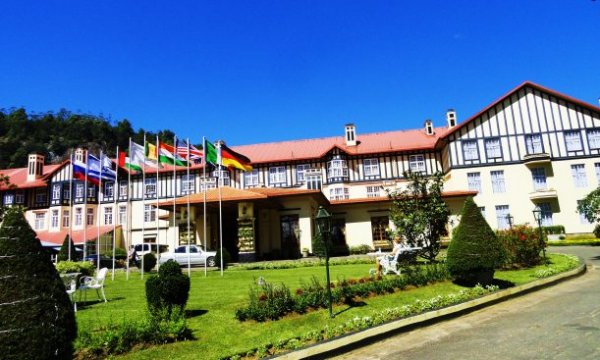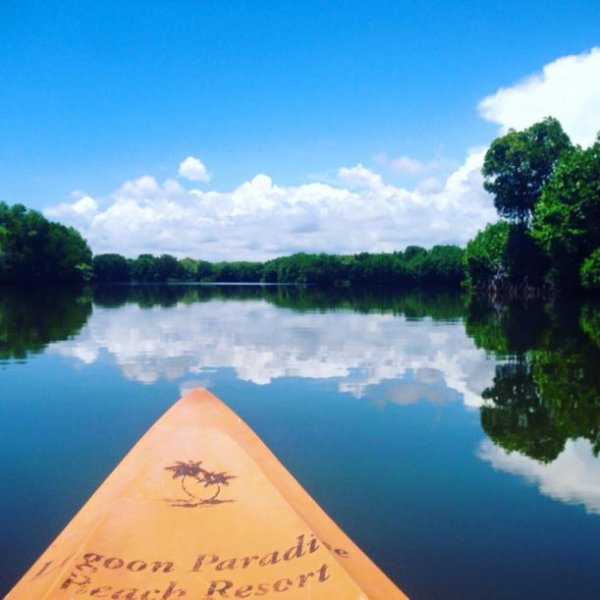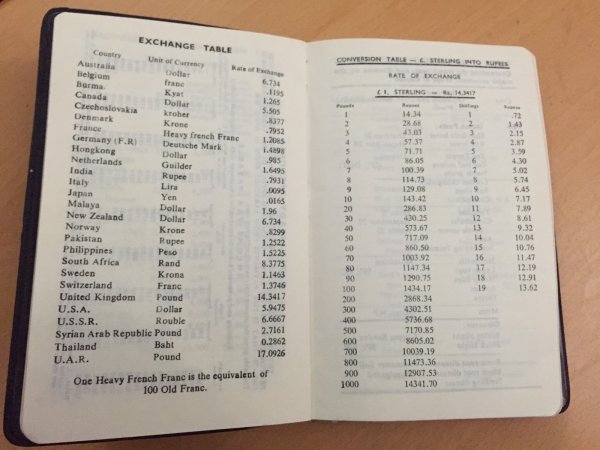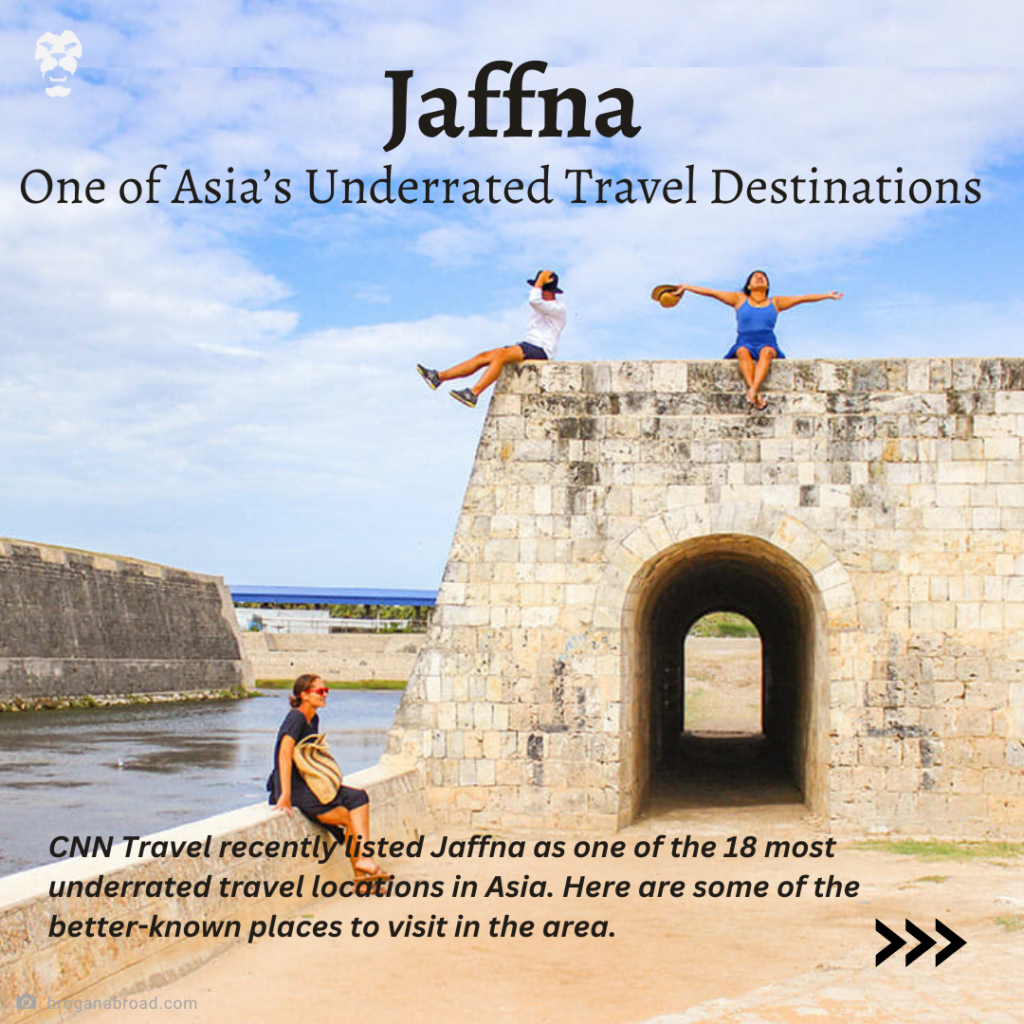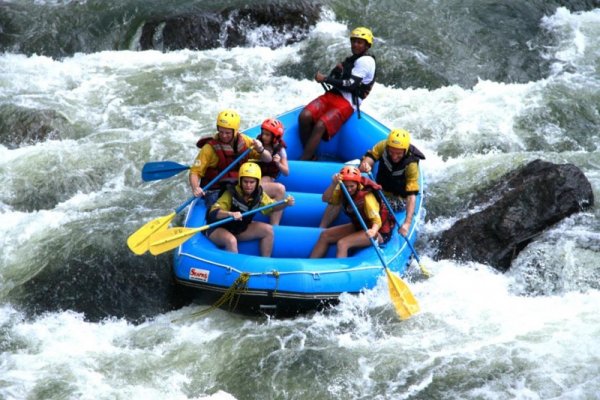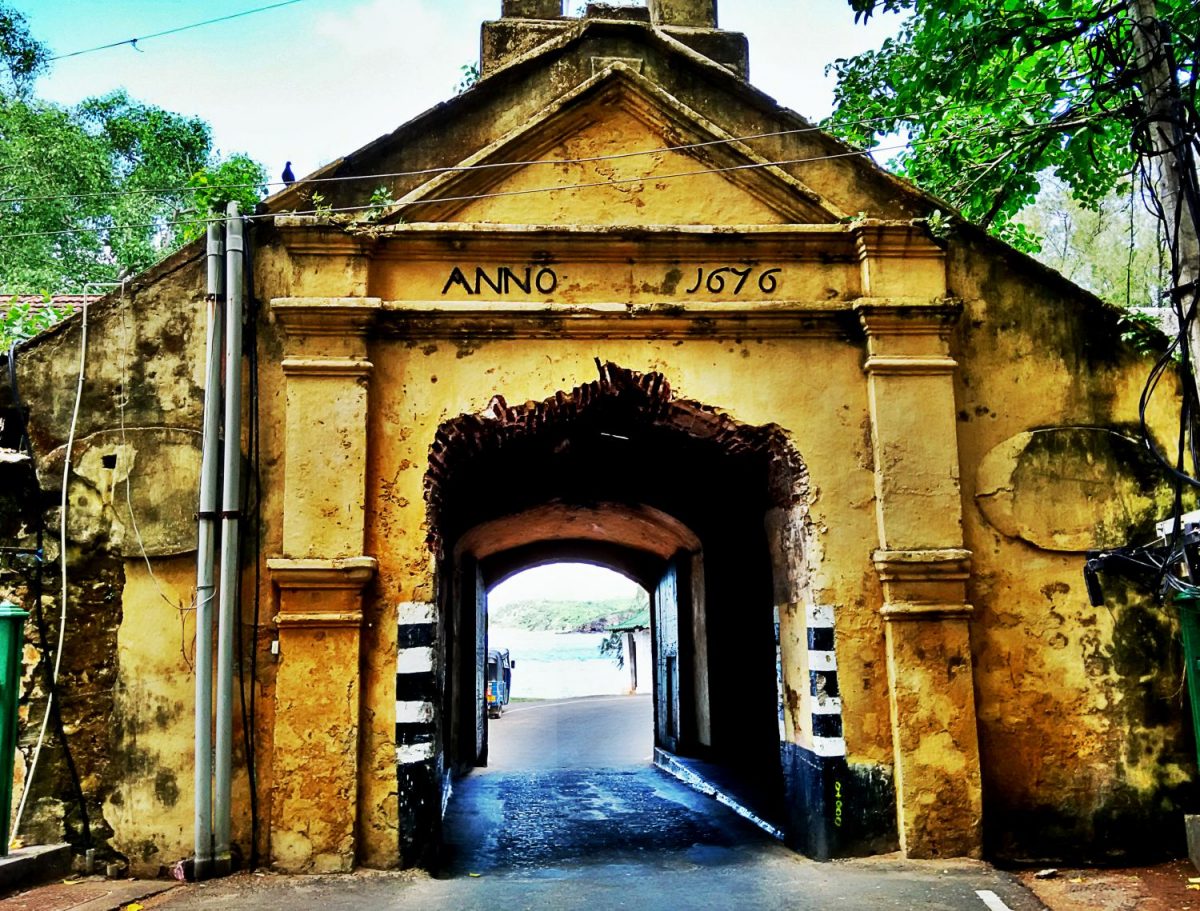
By now, most Sri Lankans and many foreigners know about the charms of Galle and the waves of Arugam Bay. Most backpackers are also aware of the spiritual solace of Kandy and the adrenaline inducing waterfalls and treks of Ella. Without a doubt, Central and Southern Sri Lanka offer some of the best retreats to every traveller.
But the beauty of Sri Lanka goes beyond these well-known destinations. It is a country that offers explorers something to look forward to no matter where they find themselves on the map. In that sense, the good news for the country and travellers alike this decade has been the termination of the war; Northern Sri Lanka is now more accessible than it has been in decades. Travellers are just trickling in, but with the government abolishing the permit requirement, tourism has definitely received a boost.
Given the lack of travel insight where the North is concerned, we understand that travellers, both Sri Lankan and foreign, would like to know a little more about what to look out for before hopping on a bus or a train. So here is our list of five destinations you could backpack to in the North, and what you could do while you are there.
Jaffna
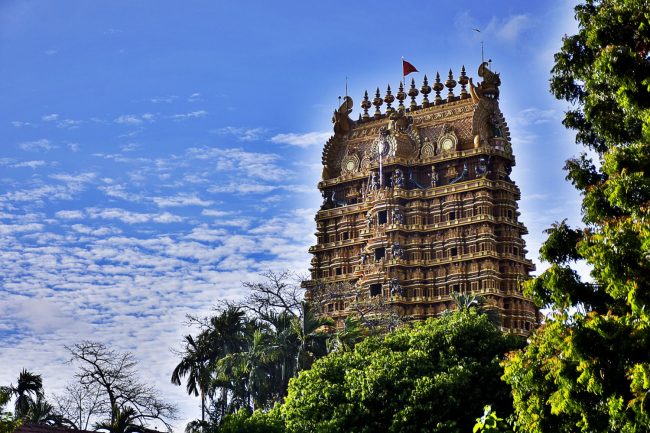
Nallur kovil in Jaffna. Image credit: Diren Dantanarayana
Jaffna is the capital of the Northern Province and before the war used to be the third largest city on the island. Decades of instability has had its impact on this peninsula city. One cannot but miss a slight melancholy touch after the sun goes down in the cultural capital of the Tamils. But it is a charming city of grand houses, fluorescent kovils and a serene coastline.
Within the city you can visit the Jaffna library which is the seat of Tamil literature. Most of you will remember that it was also torched down by nationalists a few decades ago, an event which went on to fuel the Tamil separatist movement.
Other attractions within the city include the Dutch fort, and a super spicy meal at Hotel Rolex.
The highlight of a day trip to Jaffna has to be the Nallur Kovil, named after the suburb it is located in. This kovil is dedicated to the Hindu god Murugan in the form of a vel, and there are shrines dedicated to other gods. The best time to visit this magnificent temple is around sunrise or sunset ‒ that way you get to experience the daily religious rituals. The bigger motivation, though, could be the striking view the kovil provides with the changing colours of dawn or dusk.
You’d also not want to miss the sundae or Nelli cordial at the popular ice cream parlours, Rio and Lingan, close to the kovil.
How to get there
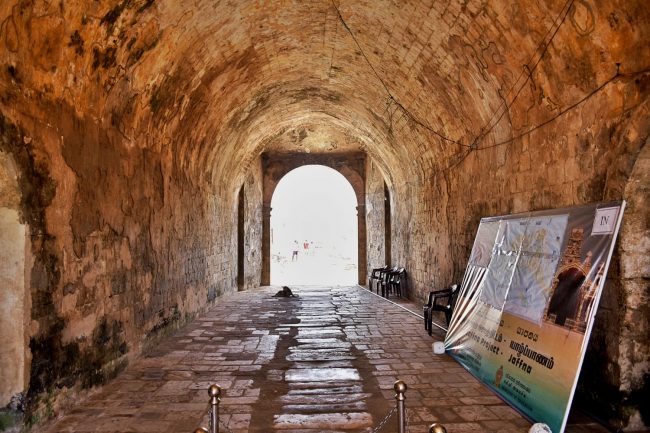
Entrance to the Dutch Fort in Jaffna. Image courtesy writer
There are buses from Pettah to Jaffna every 30 minutes or so. But the trains to Jaffna are even more fun. You can take the new Air Conditioned Intercity express or the Yaal Devi to get to the capital of the northern province.
Top Three Things to do:
- Visit Nallur Kovil around sunset, the silhouette of the structure against the changing colours of the sky is breathtaking
- Take a trip to Point Pedro, Sri Lanka’s northern-most point, to watch fishing boats sway lazily in the shallow waters of the Palk Strait
- The Jaffna public library is a must visit because of its academic and cultural importance
Budget room for two
We stayed at Green Inn for about LKR 2,000. It has clean, basic rooms but do not expect anything fancy. Also, YMCA has cheaper rooms but has mixed reviews. Plus, there are many guest houses which you need not book in advance.
Where and what to eat
Rice and curry at Hotel Rolex is spicy and satisfying, but if you want something more authentic then you will have to spend more at Hotel Lux Etoiles. But trust us, you will not be disappointed.
Dosais and idli make delicious breakfast and evening snacks at Malayan café.
How much am I going to spend?
If you stick to a budget, you can keep your costs within LKR 2,000 in Jaffna per day per person, and that includes the stay as well.
Delft Island
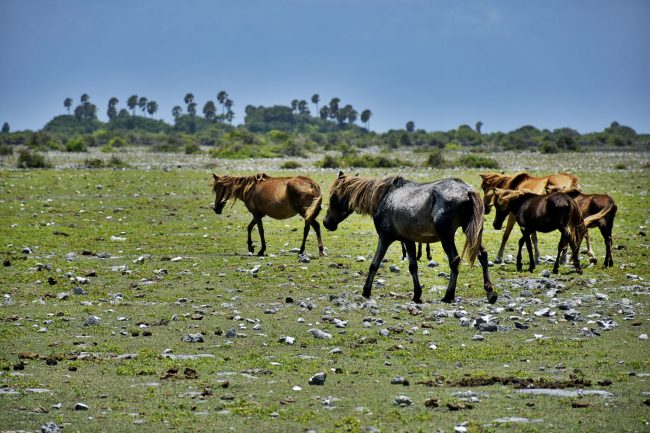
Wild Horses at Delft Island. Image credit: Diren Dantanarayana
Accessible from Jaffna is Sri Lanka’s largest island, Delft. Follow the picturesque road to Kayts Island from Jaffna, cross it and then reach Kurikadduwan. This is where you can find ferries to Delft Island, but mind you they are not available on demand. There are two in the morning and you cannot be sure if there are any to get back. But if you are a big group, you can hire a ferry for yourself. If you aren’t, then you can charm the big groups of fellow travellers from the South, who are enthusiastically discovering this part of the country, into giving you a lift.
Regardless of the not-so-easy access, Delft is really an inquisitive traveller’s delight. The island feels right out of a Tolkien novel with its surreal landscapes. It is probably the only place in the country where you can spot wild horses.
The highlight for young backpackers surely has to be the Seven Wells Beach, with buoyant waters making it really easy to float, and a perfect way to end your trip to Delft. You can then get a ferry or hitch a ride in one and pay Nagadeepa Island a visit before you head back to the mainland. Nagadeepa is famous for both a Buddhist temple and a Hindu kovil.
How to get there
Prior planning is necessary before going to Delft Island. The 776 bus leaves from Jaffna to KKD Jetty. The first bus leaves at 6:40 A.M, which is advisable, so that you make it in time to catch the morning ferry.
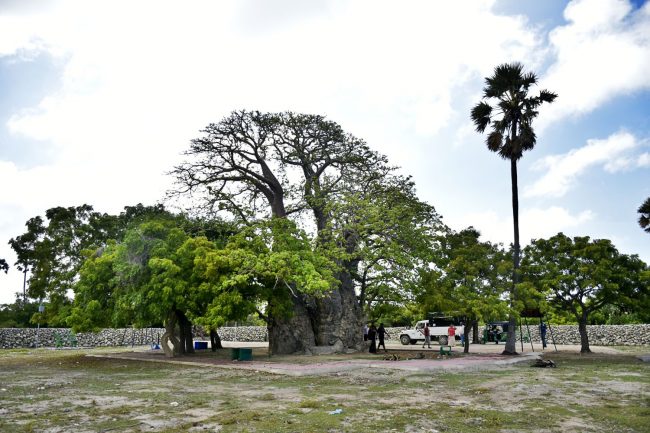
Baobab tree at Delft Island. Image credit: Diren Dantanarayana
Top 3 things to do:
- Explore the island by yourself.
- Check out the wild horses and ponies, which are quite iconic on this island.
- Have a bath at the nice, sandy beach.
Where and what to eat
The island is famous for mutton curry and seafood. Try and talk to locals or operators on the jetty, and they could arrange some from local kitchens.
How much am I going to spend?
The ferry service is run by the Navy and is free of cost. You can hire a trishaw to go around the island for the sights and that will cost you about LKR 2,500, which you can share with fellow travellers. Apart from that, expenses would mostly include food and water.
Mannar
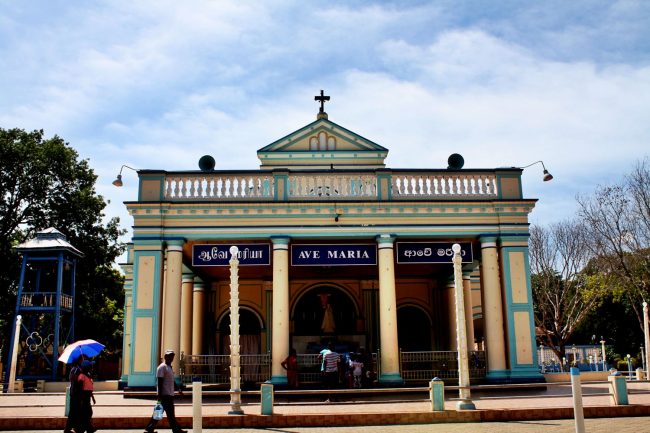
Our Lady of Madhu Church, Mannar District. Image courtesy writer
Mannar, the region with a namesake island, lies in the northwestern part of the country. When you look at Mannar island on the map, it almost seems connected to India like the finger of Adam is to God’s, a la Michelangelo’s ‘Creation of Adam’. Things get even more interesting because the island, according to one myth, is part of the bridge that Adam supposedly used to reach Sri Lanka. Of course, that isn’t the only myth associated with Mannar. Hindu mythology claims that the bridge is a part of the Ramayana and is known as ‘Rama Sethu’ meaning ‘the bridge of Rama’.
In many ways, Mannar brings together geography, history, and mythology. And not just that, the Palk Strait, separating India and Sri Lanka, is known for its marine ecology. The coastal village of Talaimannar is only 30 km from India’s Dhanushkodi, and fishermen there will be happy to take you to the second island. These islands which are visible only during low tide are said to be a part of Adam’s bridge. Talaimannar’s pier, where boats earlier left for India, is dilapidated and maybe that adds to its charm.
Back in Mannar town, you can go take a look at the many centuries old Baobab tree. The trunk of this tree is bigger than some houses. The Star Fortress with a view of the waters and the causeway is also a good place to spend time.
How to get there
Mannar is an 8-hour drive from Colombo, and taxis can be on the expensive side. Travelling by train is the most economical option. The morning train leaves at 8:50 AM and the evening train leaves at 7:15 PM from Colombo Fort.
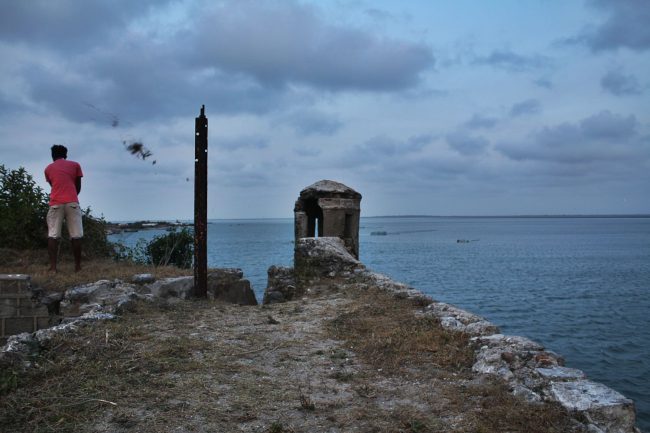
View from the Star Fortress, Mannar. Image courtesy writer.
Top 3 things to do:
- Check out the massive Baobab Tree landmark, an offbeat attraction that is supposed to have been planted by Arab traders over 700 years ago.
- Go to Mannar Fort, also called Star Fortress, an imposing structure built by the Portuguese in 1560. It makes for a delightful visit.
- Visit Our Lady of Madhu Church, where there stands a statue with a local reputation for miracles.
Budget room for two
Four Tees Rest Inn offers affordable stay with clean and well-maintained rooms (LKR 3,000 for a night for a double room), with good food. A little more expensive, Hotel Agape is also quite a good choice. But if you walk around in the bylanes close to the bus stand, you can find even cheaper options.
Where and what to eat
Look for Pilawoos near the main roundabout, which has many rice and curry options. We recommend the hoppers with seeni sambol.
How much am I going to spend?
If you stick to public transport, then about LKR 2,000 should be more than enough for you per day per person, including the place of stay.
Mullaitivu
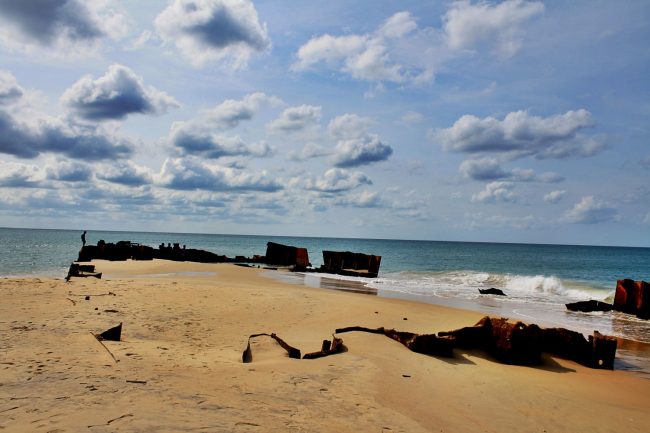
Site of Farah III at Velluvaikal beach, Mullaitivu. Image courtesy writer
This northern town, as we mentioned in a previous article, is an unlikely tourist destination. This is where the last battle of the war with the LTTE was fought. The rebel group leader’s body was reportedly found close to the town, floating in the shallow waters of Nandikadal lagoon.
Most of the attractions of the district are linked to the war, be it the Naval Museum that holds weapons and assault vehicles of the Sea Tigers, the victory monument, or the swimming pool where the Sea Tigers were said to have trained. The skeleton of the submarine that the LTTE were trying to build isn’t too far either.
The LTTE has left its mark even on Velluvaikal beach, a beautiful spot, where you can find remains of the MV Farah III which was captured by the rebel group in 2006.
A visit to Mullaitivu is for anyone who would want to understand the war better, but also for young people who want to visit these areas to interact with people; it would also make some locals happy, to know that they now live in a country free from war.
How to get there
Mullaitivu is 110 km from Jaffna, and the quickest way to get there would be to simply take a taxi, which would take just less than two hours. But for most budget travellers, buses are the best option though they take an hour longer.
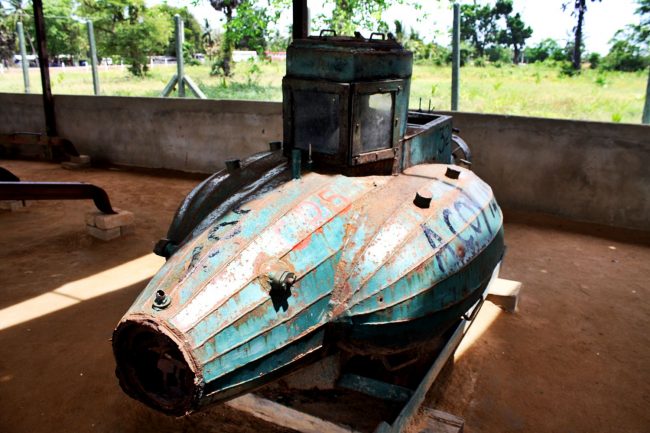
At the war Museum in Puthukkudiyiruppu, Mullaitivu. Image courtesy writer
Top 3 things to do:
- Mullaitivu was once an LTTE stronghold; you can check out the Victory Monument and War museum in Puthukkudiyiruppu
- Nandikadal Lagoon is a peaceful place to visit now, although not too long ago it was the scene of some intense armed conflict.
- See the remnants of the Farah III, a Jordanian ship which was captured by the LTTE.
Budget room for two
Mullaitivu still does not have many options for accommodation, so it’s better to take a day trip to Mullaitivu and either go back to Jaffna or head south to Trincomalee.
Where and what to eat
Mullaitivu offers delicious seafood. Look out for Mathi Hotel or Green Chilli Hotel.
How much am I going to spend?
Again, you may have to shell out about LKR 3000 for a trishaw to take you to all sites in and around Mullaitivu. If that is being split amongst three, then you can easily complete the day in LKR 2,000 ‒ 2,500.
Trincomalee
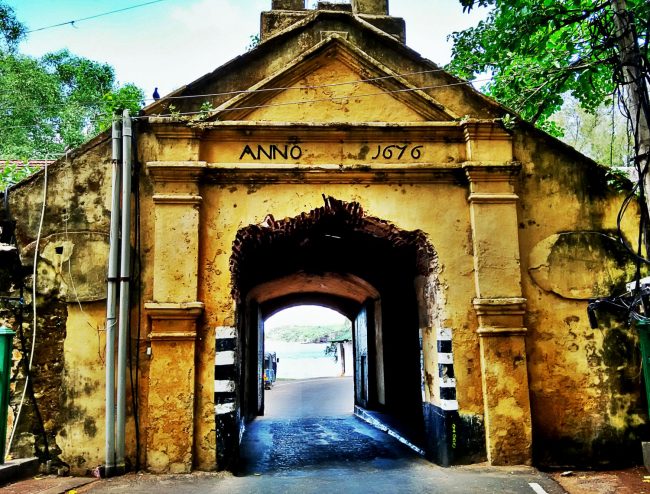
Entrance to the fort in Trincomalee. Image courtesy writer
Trincomalee, one of the few natural harbours in the world, is a jewel in Sri Lanka’s crown. Its blue, endless ocean, coupled with its history, is bound to keep intrepid travellers busy for a couple of days. The town on the eastern coast plays host to elements of Hindu mythology and Buddhist history, but also had a role to play in World War II. Since Trincomalee was the naval base of the Brits, it was attacked by the Japanese during the Indian Ocean raid of April 1942.
It also has some beaches which are perfect for family outings like the Nilaveli and Uppuveli. Pigeon island to the north is also something that cannot be missed. Apart from the beaches, make time for the Kinniya hot water springs and the war cemetery.
If there is one favourite place we have to pick in Trinco, it has to be the beautiful Koneswaran Kovil on the hillock. It offers some of the most majestic views of the Indian ocean. And beyond the physical beauty, the kovil is also a part of great story. It is said that King Ravana and his mother prayed to Lord Shiva at this shrine. On seeing his mother’s ailment, King Ravana decided to move the Kovil closer to her. It is said that as he made the first blow to the hillock with his sword, Lord Shiva appeared in person, asking him to stop.
Though the kovil continued to stay at its original spot, the sword’s blow created a cleft in the rock, which is to this date known as Ravana’s Cleft.
How to get there
Trincomalee is well connected by road to Colombo and Jaffna. There are also regular train services from Colombo to Trinco.
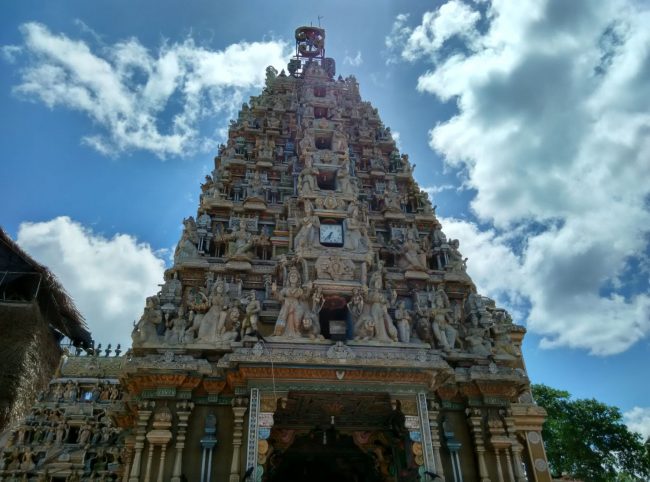
Koneswaran Temple, Trincomalee. Image courtesy writer
Top 3 things to do:
- Check out Nilaveli and Uppuveli beaches, popular among backpackers and families alike.
- Pigeon Island is a wonderful place to visit.
- The Koneswaran Kovil is worth visiting if only to indulge in local culture.
Budget rooms for two
Trinco beach resort offers very reasonable prices for good rooms and food. A room night for two people will cost about LKR 3,000. If you feel like treating yourself, head to Sea Lotus Park Hotel which is slightly more expensive, but has a great beach view.
Where and what to eat
Here, too, yummy seafood is up for grabs at King Fish Seafood, Uppuvelli. Idli and vadais are also a must.
How much am I going to spend?
It would be safe to say that LKR 3,000 per day per person is a comfortable budget for those not seeking to spend a lot.
Given the end of the war, the time is ripe for people to start exploring the island. This writer has heard some people voice apprehensions about travelling in the North but from experience, it can be safely said that travellers from elsewhere in Sri Lanka or other countries are warmly welcomed in Northern Sri Lanka. Apart from being messengers of unity and peace, travellers also bring the much-needed support that the local economy needs in these parts.
So, have you packed your bags for the North yet?
With contributions by Srikar Raghavan


